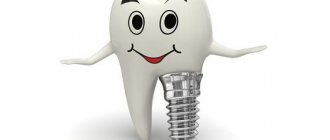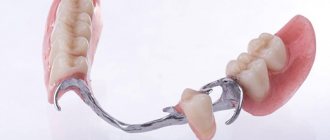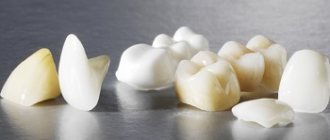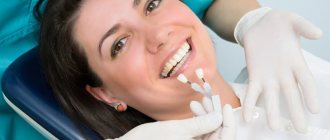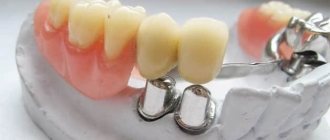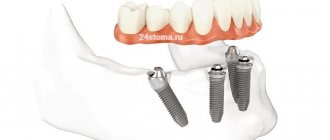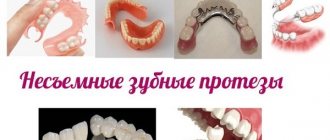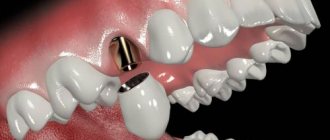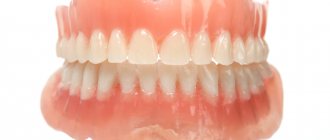Chief editor of the site:
Snitkovsky Arkady Alexandrovich
Chief physician of the professorial dentistry “22 Century”, dentist, orthopedic dentist
Author of the article:
Scientific team of dentistry “22 Century”
Dentists, candidates and doctors of medical sciences, professors
Scientific research in dentistry has shown that the processes of bone tissue regeneration and socket healing under a direct plate immediate prosthesis proceed much faster.
Loss of teeth and associated dysfunctions in chewing, speech, and appearance negatively affect the patient’s well-being. The nature and degree of this influence depends on the gender and age of the patient, profession, type of higher nervous activity, as well as on which teeth are lost. The loss of front teeth, violating aesthetic standards, can cause different reactions in a young man, a girl or an elderly person. For teachers, artists, journalists and many other specialists, the loss of front teeth means a temporary cessation of work, so the patient’s desire to receive a prosthesis as quickly as possible and to some extent compensate for the resulting defect in the dentition is understandable. In our clinic, one of the most effective ways to eliminate defects resulting from tooth extraction is the manufacture and installation of immediate dentures (direct prosthetics). This method consists in the fact that dentures are prepared before surgery, and then, immediately after the teeth are removed, they are fitted to the jaws. Scientific research in dentistry has shown that the processes of bone tissue regeneration and socket healing under a direct plate immediate prosthesis proceed much faster.
Installation of immediate dentures allows you to maintain the height of the lower part of the face, which can be changed as a result of the removal of teeth that hold the occlusal height, to evenly distribute the load on the remaining teeth and the prosthetic bed.
Immediate prosthetics are used in cases where the state of tooth mobility allows an impression to be taken without fear of removing the tooth at the time of taking the impression.
Purpose of immediate dentures
Immediate - translated from English as “immediate”, “momentary”, “urgent”. This is precisely the meaning inherent in the concept of prosthetics.
Immediate dentures are installed immediately after tooth extraction or implantation. Indispensable when a certain amount of time is required for the manufacture of a permanent prosthesis or implant healing. Such temporary intermediate structures replace missing teeth for this period and solve several problems at once:
- masking a dental defect
- elimination of psychological discomfort
- partial restoration of functionality
- prevention of growths, exostoses
- accelerated healing and protection of mucous membranes after tooth extraction
- preventing the displacement of healthy teeth towards the removed ones
- formation of a permanent prosthesis bed
- adaptation of gums to future loads
An excellent solution for a temporary solution to the problem.
Immediate dentures allow you to hide aesthetic imperfections, maintain chewing ability, and provide emotional comfort during the period of preparation for permanent prosthetics.
Levin Dmitry Valerievich Chief physician and founder of the Doctor Levin center
Glue and cream for fixing removable dentures
Models with suction cups sometimes require additional fixation. For this purpose, special fixing gels, adhesives and strips are produced. The decision on the use of such means is made by the orthopedist, who also selects the most suitable means and teaches the patient how to use it. The most popular means for fixation:
- Protefix (manufacturer: Queisser Pharma, Germany) – fixing cream with a strong immediate effect lasting from 8 to 12 hours; the price of a 47 g tube is about 230 rubles;
- Rox (BONYF, Liechtenstein) – fixing cream, lasts at least 12 hours, price about 250 rubles;
- Fittydent (FittyDent International, Austria) - considered one of the best fixation creams, lasts 12 hours, price for a 40 g tube is about 250 rubles.
Means for fixing prostheses
When using fixative creams, they must be applied strictly in accordance with the instructions. Most creams are used like this:
- Rinse and dry the structure.
- Apply a little cream to the surface of the removable denture attached to the tissue.
- Rinse your mouth.
- Place the removable denture on the jaw and bite hard for 5–6 seconds.
Instructions for use of fixing creams
Kinds
An immediate prosthesis consists of a base with soldered artificial teeth. Depending on the number of teeth lost, the design and method of attachment in the mouth differ.
- Butterfly - for the loss of 1-2 teeth A small design that contains hooks reminiscent of butterfly wings. With their help, the prosthesis rests on neighboring teeth.
- Partial - with the loss of 3 or more teeth The dimensions are more massive, which contributes to reliable fixation. The hooks are made of metal or the same material as the base.
- Complete - with complete loss of teeth. Outwardly it resembles a jaw made of plastic. It is held in place due to the suction effect on the gums and palate. Also suitable as a permanent prosthesis, in particular when fixed to implants.
Recommendations for caring for dentures
Competent regular care increases the service life of prostheses. It is recommended to wash the denture under water, preferably every time after eating. You can use a standard toothbrush with soft bristles to remove dirt and use your usual toothpaste. In order not to spoil the dentures, it is recommended to avoid foods with a viscous consistency. You should not chew chewing gum, or food with a hard consistency (nuts, crackers, toffees), or chew anything.
When storing non-dentures, you must remember that the structure should not be exposed to high temperatures to prevent cracks in the base. The product should be cleaned regularly using a special liquid or denture cleaning tablets. You can use an odor remover once every two weeks.
After installation of the prosthesis, the patient gets used to it gradually; to adjust the prosthesis, it is necessary to visit the dentist the next day after installation of the prosthesis, as well as during the first weeks if there is discomfort. The prosthesis must be worn at all times. If you do not wear a denture for 1.5 months, during this time changes will occur in your mouth, and the denture will no longer fit perfectly; a new one will need to be created.
Options for base material
Nylon or acrylic is used for the base of the prosthesis, which adheres to the gums and holds artificial crowns.
- Nylon Elastic and transparent material does not cause irritation and fits tightly to the gums. Due to its softness, the device is easy to put on. However, under the influence of temperature changes and physical activity, it gets darker. Over time, it loses its shape and is unstably fixed - it does not provide for rigid metal clasps. More suitable for replacing front teeth.
- Acrylic Cast from acrylic plastic. The material is opaque and matches the color of the gum. The rigid material holds its shape well, and the metal clasps provide a strong attachment to adjacent teeth. Acrylic immediate dentures are less aesthetic due to the opacity of the material and metal elements, but are more reliable. Recommended for chewing teeth.
Chashchin Kirill Valerievich
Orthopedic dentist, 14 years of experience
Digital prosthetics. Aesthetic restorations with veneers with a lifetime guarantee. Total orthopedic rehabilitation in one day
More about the doctor
What materials are used
Most often, acrylic is used to create temporary removable dentures - it can be easily processed and adjusted, which greatly simplifies its adaptation to the anatomical features of the jaw apparatus. Also, an immediate prosthesis can be made of nylon - this is a fairly flexible material, which is why such orthopedic products are also called soft prostheses.
If we are talking about a large number of missing teeth, then elasticity becomes a significant disadvantage. Patients complain of rapid sagging of the structure and painful chewing of food. Under a soft prosthesis, the mucous membrane sags, and the jaw bone atrophies faster. But in the case of a butterfly prosthesis, the elasticity will be minimal, so this drawback will not interfere much.
Don't know what type of prosthetics to choose?
We will help in the selection, advise where to read more information and compare types of prosthetics.
Consultation with an orthopedic doctor in Moscow clinics is free! Call now or request a call
Working hours: from 9:00 to 21:00 - seven days a week
Today, modern Acry-Free material is also used to create immediate dentures. It is also called new generation acrylic, which does not contain monomers, so it is considered hypoallergenic. This is a fairly elastic material, but not too much, as is the case with nylon. It is characterized by many undeniable advantages, and therefore the cost of a prosthesis made from the Acri-Free material will be much higher. And considering that such a system usually only needs to be worn for a few weeks or a couple of months, you need to evaluate how justified the high investment will be.
It is interesting that some netizens are looking for the “butterfly” prosthesis as a “bird” prosthesis, apparently forgetting its name. Note that there is no difference between them - we are talking about the same design.
Advantages
Prompt production, the ability to quickly restore lost teeth, and low cost make immediate dentures indispensable in preparation for permanent prosthetics.
- Speed Installed on the day of tooth extraction; no preliminary preparation or grinding of adjacent crowns is required.
- Aesthetics The base is matched to the color of the gums, the crowns to the color of the adjacent teeth. The dentures look harmonious and are almost invisible.
- Comfort Getting used to it is quick; after a few days you won’t feel the prosthesis in your mouth. The structures are lightweight and do not put pressure on the gums.
- Cost Manufacturing costs are relatively low, while the quality corresponds to the temporary purpose of the prostheses.
How to get used to removable dentures
Adaptation is necessary for complete removable prosthetics, as well as for direct prosthetics, when the patient has lost more than half of his teeth. The adaptation period for each patient has its own individual characteristics and duration. On average, it lasts from three weeks to two months. In this case, it is necessary to distinguish between normal physiological reactions to the presence of a foreign object in the oral cavity and pathological processes that require immediate consultation with a doctor.
Normal adaptation
During the adaptation period, the body gradually gets used to removable dentures, which is accompanied by a number of physiological reactions. In each patient, these reactions may be more or less pronounced, and some of them may be absent. Normal adaptation symptoms:
- feeling of discomfort in the mouth;
- drooling or, conversely, increased dry mouth - depends on the mechanical effect of the structure on the salivary glands;
- moderate pain that appears when chewing - it can be due to the pressure of the model on the gums or muscle spasm;
- loss of taste - often occurs when installing a complete removable plate denture that covers the taste buds in the palate;
- nausea and gag reflex - this does not occur in everyone, but if it persists for a long time, the dentist may decide to remove the structure;
- gum irritation;
- slurred speech;
- prolonged stress against the background of difficult adaptation.
No matter what removable dentures are installed, there will always be adaptation. To reduce adaptation symptoms, you need to:
- strictly adhere to the rules of oral care recommended by the orthopedist;
- if the unpleasant symptoms do not bother you too much, it is better not to remove the structure at night for the first few days - this will allow adaptation to happen faster;
- to suppress the gag reflex, use a breathing technique: inhale slowly through the nose for 4 seconds, hold your breath for 3 seconds, exhale slowly through the mouth - 6 seconds; breathe like this until the urge to vomit passes;
- to eliminate problems with salivation when it increases, rinse your mouth with saline solution (a level teaspoon per glass of water); if you are dry, you need to drink more regular boiled water;
- to eliminate pain and discomfort when chewing, eat only soft and liquid foods in the first week; You can gradually introduce more solid foods, but you will have to give up nuts and seeds forever;
- to strengthen the gums, massage: remove the removable denture, rinse your mouth, massage the gums with your fingertips for 5 minutes; this will improve blood circulation and prevent the development of irritation;
- to eliminate irritation and prevent inflammatory processes, use special dental gels, for example, Metrogyl Denta;
- to improve diction - from the first day of installing a removable denture, talk and read aloud more; Over time, speech will be restored.
Pathological processes during adaptation
A removable dental process installed on the jaw can cause severe irritation of the gums, which is often accompanied by infection. Symptoms of this complication may be: increasing pain when chewing, persisting after eating, redness and swelling of the gums, discharge of pus, and sometimes a slight increase in body temperature. Such symptoms cannot be tolerated, since the infection can spread to other organs and tissues with the development of purulent inflammatory processes. The only correct solution in this situation would be to urgently consult a dentist to treat the complication.
Computer diagnostics - for reliable data
It is performed on a GALILEOS tomograph (The Dental Company SIRONA, Germany).
- Assessment of bone tissue to determine the parameters of the prosthesis base
- Study of the position and functions of the temporomandibular joint
- Determination of the condition of abutment teeth during partial dentures
Features of care
The most important thing is to maintain oral hygiene and systematically brush your teeth twice a day. At this time, the structure should be removed and also cleaned with a soft toothbrush and non-abrasive toothpaste. No additional antiseptic treatment is required.
It is not recommended to remove the structure at night, mainly to avoid displacement of the teeth adjacent to the defect. Even with a slight change in their position, the prosthesis may become uncomfortable and begin to cause serious discomfort.
Own digital laboratory - speed and quality
The Center has a digital dental laboratory with a staff of experienced qualified dental technicians.
- Direct and immediate interaction between the orthopedist and the dental technician
- Highly accurate digital impressions without impression material errors
- Fast terms of prosthetics, no restrictions on the number of fittings
What is a nylon prosthesis
Removable nylon dentures are soft orthopedic structures made of a pink, gum-colored nylon base with invisible clasps that hold it in the mouth. The fixation is on the adjacent teeth; the hooks wrap around the supports, keeping the prosthesis stationary on the jaw. Artificial crowns are placed on an elastic frame.
A person can take off and put on a nylon prosthesis without assistance. They are used in dentistry as a temporary solution during implantation (during the process of osseointegration) or as a permanent prosthesis according to indications.
Nylon is a polymer that has the quality of flexibility, and under certain conditions, in the patient’s mouth, softness increases. As a denture material, it has come as an alternative to dental acrylic, to which some people are allergic.
Partial nylon prosthesis RUR 40,000. for all!
The price includes: diagnostics, impressions, manufacturing, installation, fitting and 1 year warranty! Complete denture Akrifri 1 jaw - 47,000 rub.!
Stages of prosthetics
As a rule, fixation of an immediate prosthesis is carried out immediately after tooth extraction or implantation.
- Taking impressions Even before tooth extraction or implant installation, impressions are taken, from which an immediate denture is made in a dental laboratory within 1-3 days according to the patient’s individual parameters.
- Installation On the day of surgery, the causative tooth is removed or an implant is installed. While the anesthesia is still in effect, the finished immediate prosthesis is fixed. A person instantly receives a new tooth to replace the lost one.
Indications for installation of a removable prosthetic module with clasps
A Butterfly can be temporarily installed if the patient has:
- Relative contraindications to implantation have been identified that can be eliminated.
- At the moment there is no money to install an implant, but such an operation is planned in the future.
- There is no desire to grind down the teeth adjacent to the defect in order to fill the gap between them with the help of a fixed bridge.
Sometimes an immediate structure is installed for temporary use, but a person continues to wear it for several years because he is satisfied with everything. However, it is important to understand that for permanent use it is advisable to choose a different, more functional type of prosthetics.
Life time
Since the main purpose of prostheses is short-term prosthetics, the service life is limited to 3-4 months. This is enough for the healing of soft tissues after tooth extraction or implant installation. Longer wearing is not recommended, since the structures lose their shape and can have a negative effect on the gums in the area of the supporting teeth. If it is impossible to install a permanent structure after this period, it is necessary to replace the immediate prosthesis with a new one.
But it should be taken into account that lightweight structures do not put pressure on bone tissue; with a temporary solution after tooth extraction, they can cause jaw atrophy due to improper load distribution, which will become a problem before installing an implant.
Cost of installing a temporary prosthesis
Prices for a removable immediate prosthesis in Moscow and the region are quite low, and people with different income levels can get it. The price is affected by:
- structure structure;
- complexity of the clinical situation;
- number of teeth covered.
| Service | Price |
| Consultation with specialists and treatment plan | |
| Complete removable temporary denture | 17 850 ₽ |
| Partially removable temporary denture for 1-3 teeth | 10 600 ₽ |
| Partially removable temporary prosthesis | 16 150 ₽ |
Make an appointment now - take the main step towards a perfect smile!
Expert of the article you are reading: Lutov Sergey Mikhailovich Therapist, orthopedic dentist, surgeon
24 years
Clinical experience
Otradnoe
st. Khachaturyan, 7
+7 +7
Free consultation with this specialist
Contraindications
What may be a contraindication to a nylon prosthesis in dentistry:
- periodontal diseases (grade 3-4 periodontal disease), loose teeth, their displacement;
- recession;
- the height of the supporting teeth is not enough, the clasps will not be able to securely fasten;
- inflammatory processes of the mucous membrane and gums;
- tooth mobility;
- significant bone atrophy.
It is necessary to have healthy teeth on both sides of the prosthesis as supports for clasp fixation.
How to determine quality
Temporary orthopedic structures are made of plastic. They are not as strong and reliable as permanent ones, but should provide normal chewing function until the denture procedure is completed. High-quality dentures meet the following criteria:
- Aesthetics.
- Hypoallergenic.
- Comfortable to wear.
- Strength.
When a product meets these requirements, it will not only allow you to lead a normal life, but also reduce the period of adaptation to prostheses.
Differences between fixation on the upper and lower jaw
Partial dentures are fixed to the gums using a base, as well as to supporting teeth using hooks. The device looks like a plastic arch with artificial crowns. The main difference is in the design of the palatal bridge.
The dentures for the top row are equipped with an artificial plastic palate (solid plate). The element increases the area of contact surfaces, thereby improving fixation. The devices are bulky, making it more difficult for patients to get used to them. But in the new generation of prostheses, this element is made in the form of a ring or arc, which makes the design easier.
On the lower jaw the bridge is narrow due to the frenulum of the tongue. The contact area is small, but this reduces the quality of fixation.
Stages of manufacturing a flexible prosthesis
To create nylon dentures, you must first treat the teeth, perform removal according to indications, and then proceed to the following steps:
- taking impressions of jaws in a clinical setting;
- plaster models are made in the laboratory;
- a wax prototype of the prosthesis is cast, tried on, and finalized;
- a nylon final version is created, matched to the color of the gum. The equipment used is a heat press, in which polymer granules are melted and an individual mold is poured in a liquid state. After hardening, the structure is polished.
Clasps are a continuation of nylon dentures and are therefore completely invisible on the jaw even when smiling and talking.
